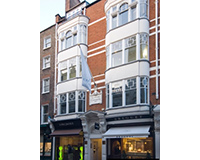London’s most luxurious shopping street is now almost half-owned by the retailers on it as fears over skyrocketing rents lead them to become landlords.
Last week Cartier parent Richemont and Oxford Properties splashed out £300m – a 2.4% yield – buying five properties at 130-137 New Bond Street, W1, (12 July, p33), taking the number of shops on Bond Street owned by occupiers to 39, according to research from DTZ.
Richemont, like Prada and Fenwick, which have both bought on the street in recent months, is expected to use some of the space for its own brands.
DTZ says the increase in retailers purchasing freeholds comes despite soaring prices and some yields of below 2%. Investors continue to be attracted to strong footfall and the pending arrival of Crossrail.
However, the rate of growth of retail landlords is unusual, says Mark Shipman, a director at West End specialist Michael Elliott.
“In my 25 years working on Bond Street, a number of Italian and French brands have quietly amassed properties, but I have never seen as many occupiers buying as I have in the past 12 months,” Shipman says.
So what is fuelling this trend of retailers buying freeholds to use for their own brands and London headquarters. And will it continue?
If rents continue to rise on the street at the current rate, the answer is yes, according to Colliers International.
Retail zone-A rents have risen from £750 per sq ft in 2009 to £1,200 per sq ft on average this year, the agent says. Office rents have shot up by 77% during the same period to £115 per sq ft.
And it reckons that retail and office rents will jump to £1,450 per sq ft zone A and £122.50 per sq ft respectively by 2018.
Premiums for leases on Bond Street shops also continue to rise. In February Watches of Switzerland sold the lease on its 1,200 sq ft store at 16 New Bond Street to watchmaker Patek Philippe for £10m, a record price per sq ft. The following month corset maker La Perla paid a premium of £5m for 1,000 sq ft at 9 Old Bond Street.
David Harper, chief executive of retail specialist Harper Dennis Hobbs, says that a number of luxury retailers he has advised have bought buildings as a strategy to make sure they are not let to their rivals. It is a strategy that has long been common in global fashion spot Milan, he explains.
“By owning the properties, companies feel safer to invest in them and have authority over the layout of the shops,” says Harper.
The fashion giants will continue to face stiff investment competition to dominate Bond Street, according to Fergus Keane, head of West End investment at DTZ.
Keane says that Far Eastern money continues to want a slice of prime West End, as do a host of new international entrants looking for a safe haven.
Far Eastern investors now own nine of the 80 properties on Bond Street, tripling their ownership in a year (7 September 2013, p48).
But with buildings on the street rarely coming to market, demand will remain strong, particularly from global occupiers.
“I would expect no slowdown in luxury goods companies buying properties for their own occupation,” says Keane.
“If rents continue to rise, and trade continues favourably, these firms know they need Bond Street within their portfolios for branding and cache, and for the experience these flagship stores impart on to their customers.”
joanna.bourke@estatesgazette.com











